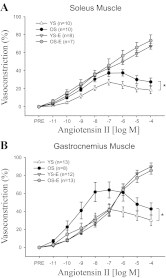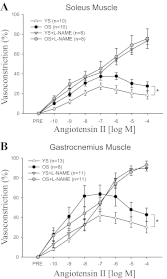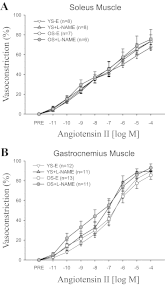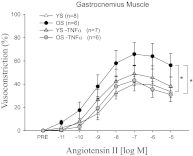Effects of aging, TNF-α, and exercise training on angiotensin II-induced vasoconstriction of rat skeletal muscle arterioles
- PMID: 22923503
- PMCID: PMC3487496
- DOI: 10.1152/japplphysiol.00292.2012
Effects of aging, TNF-α, and exercise training on angiotensin II-induced vasoconstriction of rat skeletal muscle arterioles
Abstract
Skeletal muscle vascular resistance during physical exertion is higher with old age. The purpose of this study was to determine whether 1) aging enhances angiotensin II (ANG II)-induced vasoconstriction; 2) the proinflammatory cytokine tumor necrosis factor (TNF)-α contributes to alterations in ANG II-mediated vasoconstriction with aging; 3) exercise training attenuates putative age-associated increases in ANG II-mediated vasoconstriction; and 4) the mechanism(s) through which aging and exercise training alters ANG II-induced vasoconstriction in skeletal muscle arterioles. Male Fischer 344 rats were assigned to four groups: young sedentary (4 mo), old sedentary (24 mo), young trained, and old trained. In a separate group of young sedentary and old sedentary animals, a TNF type 1 receptor inhibitor was administered subcutaneously for 10 wk. First-order arterioles were isolated from soleus and gastrocnemius muscles for in vitro experimentation. Old age augmented ANG II-induced vasoconstriction in both soleus (young: 27 ± 3%; old: 38 ± 4%) and gastrocnemius (young: 42 ± 6%; old: 64 ± 9%) muscle arterioles; this augmented vasoconstriction was abolished with the removal of the endothelium, N(G)-nitro-l-arginine methyl ester, and chronic inhibition of TNF-α. In addition, exercise training ameliorated the age-induced increase in ANG II vasoconstriction. These findings demonstrate that old age enhances and exercise training diminishes ANG II-induced vasoconstrictor responses in skeletal muscle arterioles through an endothelium-dependent nitric oxide synthase signaling pathway. In addition, the enhancement of ANG II vasoconstriction with old age appears to be related to a proinflammatory state.
Figures








Similar articles
-
Ageing and exercise training alter adrenergic vasomotor responses of rat skeletal muscle arterioles.J Physiol. 2007 Feb 15;579(Pt 1):115-25. doi: 10.1113/jphysiol.2006.120055. Epub 2006 Nov 2. J Physiol. 2007. PMID: 17082231 Free PMC article.
-
Exercise training enhances flow-induced vasodilation in skeletal muscle resistance arteries of aged rats: role of PGI2 and nitric oxide.Am J Physiol Heart Circ Physiol. 2007 Jun;292(6):H3119-27. doi: 10.1152/ajpheart.00588.2006. Epub 2007 Mar 2. Am J Physiol Heart Circ Physiol. 2007. PMID: 17337602
-
Effects of ageing and exercise training on endothelium-dependent vasodilatation and structure of rat skeletal muscle arterioles.J Physiol. 2004 May 1;556(Pt 3):947-58. doi: 10.1113/jphysiol.2003.060301. Epub 2004 Mar 5. J Physiol. 2004. PMID: 15004211 Free PMC article.
-
Microvascular mechanisms limiting skeletal muscle blood flow with advancing age.J Appl Physiol (1985). 2018 Dec 1;125(6):1851-1859. doi: 10.1152/japplphysiol.00113.2018. Epub 2018 Nov 9. J Appl Physiol (1985). 2018. PMID: 30412030 Free PMC article. Review.
-
Mechanisms for exercise training-induced increases in skeletal muscle blood flow capacity: differences with interval sprint training versus aerobic endurance training.J Physiol Pharmacol. 2008 Dec;59 Suppl 7(Suppl 7):71-88. J Physiol Pharmacol. 2008. PMID: 19258658 Free PMC article. Review.
Cited by
-
Age and exercise training alter signaling through reactive oxygen species in the endothelium of skeletal muscle arterioles.J Appl Physiol (1985). 2013 Mar 1;114(5):681-93. doi: 10.1152/japplphysiol.00341.2012. Epub 2013 Jan 3. J Appl Physiol (1985). 2013. PMID: 23288555 Free PMC article.
-
Exercise ameliorates endoplasmic reticulum stress-mediated vascular dysfunction in mesenteric arteries in atherosclerosis.Sci Rep. 2018 May 21;8(1):7938. doi: 10.1038/s41598-018-26188-9. Sci Rep. 2018. PMID: 29784903 Free PMC article.
-
Differential effects of aging and exercise on intra-abdominal adipose arteriolar function and blood flow regulation.J Appl Physiol (1985). 2013 Mar 15;114(6):808-15. doi: 10.1152/japplphysiol.01358.2012. Epub 2013 Jan 24. J Appl Physiol (1985). 2013. PMID: 23349454 Free PMC article.
-
Impact of high-fat diet on vasoconstrictor reactivity of white and brown adipose tissue resistance arteries.Am J Physiol Heart Circ Physiol. 2019 Mar 1;316(3):H485-H494. doi: 10.1152/ajpheart.00278.2018. Epub 2018 Dec 14. Am J Physiol Heart Circ Physiol. 2019. PMID: 30550353 Free PMC article.
-
Short-duration increases in intraluminal pressure improve vasoconstrictor responses in aged skeletal muscle feed arteries.Eur J Appl Physiol. 2016 May;116(5):931-7. doi: 10.1007/s00421-016-3350-x. Epub 2016 Mar 14. Eur J Appl Physiol. 2016. PMID: 26976132
References
-
- Aoki N, Siegfried M, Lefer AM. Anti-EDRF effect of tumor necrosis factor in isolated, perfused cat carotid arteries. Am J Physiol Heart Circ Physiol 256: H1509–H1512, 1989 - PubMed
-
- Beere PA, Russell SD, Morey MC, Kitzman DW, Higginbotham MB. Aerobic exercise training can reverse age-related peripheral circulatory changes in healthy older men. Circulation 100: 1085–1094, 1999 - PubMed
-
- Behnke BJ, Delp MD, Dougherty PJ, Musch TI, Poole DC. Effects of aging on microvascular oxygen pressures in rat skeletal muscle. Respir Physiol Neurobiol 146: 259–268, 2005 - PubMed
-
- Belmin J, Bernard C, Corman B, Merval R, Esposito B, Tedgui A. Increased production of tumor necrosis factor and interleukin-6 by arterial wall of aged rats. Am J Physiol Heart Circ Physiol 268: H2288–H2293, 1995 - PubMed
-
- Berry C, Touyz R, Dominiczak AF, Webb RC, Johns DG. Angiotensin receptors: signaling, vascular pathophysiology, and interactions with ceramide. Am J Physiol Heart Circ Physiol 281: H2337–H2365, 2001 - PubMed
Publication types
MeSH terms
Substances
Grants and funding
LinkOut - more resources
Full Text Sources
Medical
Miscellaneous

